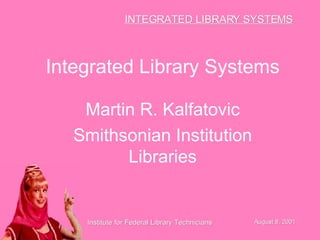Integrated Library Systems
- 1. Integrated Library Systems Martin R. Kalfatovic Smithsonian Institution Libraries
- 2. Ėý
- 3. Elements of an ILS
- 4. Elements of an ILS Circulation Acquisitions Cataloging
- 5. Elements of an ILS Serials Control Integration with Other Information Resources Selection
- 6. Circulation
- 7. Circulation A fairly simple aspect of the library to automate, since it is basically an inventory system ...
- 8. Circulation Often the first aspect of libraries to be automated ...
- 9. Circulation Very basic hardware needed for circulation:
- 10. Circulation Central Processing Unit (CPU) Barcode Wand (or similar device) Keyboard Printer Storage Device
- 11. Circulation Item Records (Bibliographic Records)
- 12. Circulation
- 13. Circulation
- 14. Circulation âĶ and Patron Records need only minimal information to be effective...
- 15. Circulation
- 16. Circulation
- 17. Circulation
- 18. Circulation Must be an ONLINE versus OFFLINE Activity.
- 19. Acquisitions
- 20. Acquisitions Key elements: Item Record (need not be extensive) âĶ
- 21. Acquisitions
- 22. Acquisitions âĶ Vendor Information âĶ
- 23. Acquisitions
- 24. Acquisitions âĶ and Account Information.
- 25. Acquisitions Maintain standing and serial orders Track funds Keep balances Must:
- 26. Acquisitions Transmit data to vendors (via printed forms or, increasingly, electronically) Integrate into the OPAC (e.g. display "on order" records to the public) Must:
- 27. Cataloging
- 28. Cataloging Must be able to handle standard formats such as MARC and MARC Holdings as well as integrate non-MARC formats in certain situations (e.g. archival records)...
- 29. Cataloging Must maintain Authority Records in a standard manner...
- 30. Cataloging
- 31. Cataloging
- 32. Cataloging
- 33. Cataloging
- 34. Cataloging
- 35. Cataloging Must link with appropriate bibliographic utilities (e.g. OCLC and RLIN)
- 36. Cataloging
- 37. Serials
- 38. Serials Often the most complex automation task due to the periodic nature of serials and the labor intensive efforts for retrospective conversion of manual serial files.
- 39. Serials
- 40. Serials
- 41. Serials
- 42. Serials
- 43. Serials
- 44. Serials
- 45. Serials
- 46. OPAC
- 47. OPAC Many vendors remain, but there has been much consolidation in the industry in the past few years...
- 48. OPAC And interfaces have changed over the years âĶ
- 49. OPAC Character-based Proprietary GUI Telnet (vt100, etc.) Web-based Z39.50 interface
- 50. OPAC
- 51. OPAC
- 52. OPAC
- 53. OPAC
- 54. OPAC
- 55. Integration
- 56. Integration
- 57. Integration
- 59. Integration ALADIN SIRIS Provide links to other information resources:
- 60. Selection
- 61. Selection Rapid Change - the average lifespan of an ILS is 3-5 years; vendors are consolidating and merging ...
- 62. Selection This rapid rate of change will have an impact on staff training, patron training, budgets, workflow -- in essence, all elements of your library work.
- 63. Selection With proper planning, the disruptions of incurred with implementing a new system can be minimized (but never eliminated!).
- 64. Conclusion
- 65. Ėý

































































